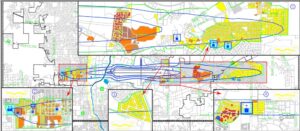Historic Noise Analysis and Programs
The Reno-Tahoe Airport Authority (RTAA) has a long history of working with the surrounding communities in addressing airport noise issues. In 1979, the RTAA completed its first comprehensive noise study for the Reno-Tahoe International Airport (RNO) which is referred to as the Airport Noise Control and Land Use Compatibility (ANCLUC) Study. Following this effort, the Federal Aviation Administration (FAA) created the Federal Aviation Regulations (FAR) Part 150 Noise Compatibility program in 1984. Participation on the part of airports in the FAR Part 150 program is voluntary and for those that do participate additional funding is made available. Because of the RNOs in-town location and the availability of additional funding to benefit the communities, the RTAA initiated its first FAR Part 150 Noise Compatibility Study in 1989 and it was approved by the FAA in 1991. An update to the FAR Part 150 study was initiated in 2000. The final study was approved by the FAA in 2004.
Part 150
The FAR Part 150 Noise Compatibility Study provides both operational and land use recommendations for reducing or eliminating noise impacts around Reno-Tahoe International Airport. The following documents are excerpts from the most recent FAR Part 150 Study and provide an overview of the Noise Exposure Maps and the recommendations to manage the noise impacts at Reno-Tahoe International.
To view these reference pages from the updated FAR Part 150 Noise Compatibility Study, use the following links:
- Chapter 4 – Noise Impacts
- Chapter 5 – Noise Abatement Alternatives
- Exhibit 4C – 2000 Aircraft Noise Exposure with Land Use
- Exhibit 4D – 2005 Aircraft Noise Exposure with Land Use
- Exhibit 4E – 2010 Aircraft Noise Exposure with Land Use
- Exhibit 5G – Evaluate Preferential Runway Use for Noise Abatement
Successful Residential Sound Insulation Program (SIP)
The Reno-Tahoe Airport Authority completed the residential sound program in 2014, nearly 20 years after the program’s inception in 1995, and helped insulate more than 5,100 residential units north and south of RNO. This program is an outstanding example of the airport’s efforts to blend its operations with the community while maintaining a high quality of life for the airport’s neighbors.
At the program’s conclusion, over 95% of 5,400 qualified units, with interested homeowners, had received noise mitigation construction improvements (primarily the replacement of existing windows and doors with acoustically rated products). More than $68 million was invested in insulating homes within the eligible area, with an average design and construction cost per home of $15,000 – which was at no cost to the homeowner.
Click to enlarge the map
The Airport Authority had been receiving Airport Improvement Program (AIP) grant funding from the Federal Aviation Administration (FAA) for the purpose of sound insulating homes in communities neighboring Reno-Tahoe International Airport each year dating back to 1994. The Reno-Tahoe Airport Authority was eligible to receive these funds because of the Airport Authority’s participation in the voluntary Federal Aviation Regulations (FAR) Part 150 Noise Compatibility Program that identified specific areas of noise exposure to homes located primarily to the north and south of the airport in Sparks, Reno, and unincorporated Washoe County.
Eligible homes met this criteria:
- Built (Certificate of Occupancy of Final Inspection) prior to October 1, 1998
- Used for residential purposes – Commercial properties and residences which had been converted to commercial use were not eligible
- A permanent structure (not a mobile home)
- Within the FAA-approved 65 decibel (dB) DNL (Day Night Average Level) Noise Exposure area (based on an annual average, e.g. 365 days a year, 24 hours a day) as identified in the Part 150 program
- Experiencing interior noise levels greater than 45 dB in the habitable rooms with the windows closed
- Commercial properties and residences which have been converted to commercial use were not eligible
The Reno-Tahoe International Airport does not have a property acquisition program and has completed the sound insulation program.
For those persons interested in sound insulating their own home, the Airport Authority provides a Residential Noise Mitigation Best Practices Guide.
Find more information about airport noise compatibility and how to file a noise complaint.
Questions regarding the Airport Authority’s former residential sound insulation program, or should be directed to noiseline@renoairport.com.

